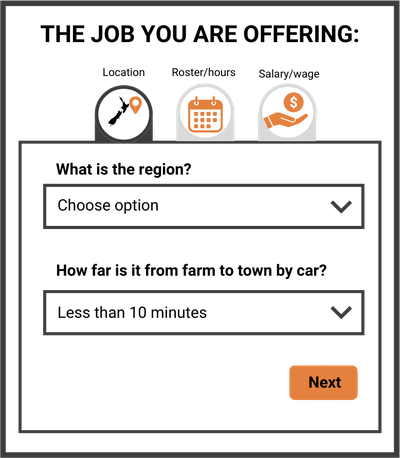What Does Collaboration and Co-design Mean?
We often hear the terms collaboration and co-design as we plan and undertake projects, but what do these mean in practice?
As an employer, the first step to attracting and retaining people is putting forward your best offer. To do this, you need to understand what employees value most.

Written by

Superpower: Dishwasher stacking
Fixations: The Far Side
Adam founded Scarlatti in 2004 and is still very much hands-on and at the wheel. His work for clients spans most of the areas that Scarlatti operates in including extension programme design, social and market research, workforce research, impact modelling and operations research.
His idea of a good time consists of interrogating a problem down to its logical roots then working his way back up to find solutions. Much of the time this is useful to Scarlatti’s clients although Adam’s wife and children are less convinced.
Important to Adam, is developing the Scarlatti team by creating opportunities for team members to grow and lead. Scarlatti’s clients also appreciate the strong team culture that Adam has aspired to build.
Adam was previously Chief Operating Officer of Celentis, a commercial science company owned by AgResearch, and before that was a consultant for leading strategy consultancy McKinsey & Company, based in London.
Adam holds a Bachelor of Engineering (First Class Honours) from the University of Auckland and a Doctorate in Engineering from the University of Cambridge, United Kingdom.
Many of New Zealand’s primary industries face a common challenge: attracting and retaining people.
In this job market, there are often more jobs than people available making the primary industry employment market an ‘employees market’ where potential employees sit in the bargaining position in terms of wage, location, benefits, and hours. A savvy potential employee could name their price.
As an employer, the first step to attracting and retaining people is putting forward your best offer. To do this, you need to understand what employees value most.
If employers understand how competitive their job offer compares to other similar jobs within their sector and other sectors, they can refine their offers to attract the best applicants. They can also cast their nets wider and reach potential candidates from outside of their primary industry. This means understanding what job factors (aside from wages) have the most influence on potential employees.
Job factors aside from wages can significantly influence a candidate’s decision. For example, in dairy farming, potential candidates may perceive remote locations, long hours, early starts and rosters that involve working weekends, as ‘costs’. If we know how important candidates perceive these non-wage attributes to be, we can calculate how much the wage for a specific job would need to be adjusted upwards to be competitive with other roles that require a comparable level of skills and experience but are less remote, with fewer hours, and are more “9 to 5”, Monday to Friday.
The Scarlatti team worked with DairyNZ on their “Know the Market” project, an initiative to help dairy farm employers understand the competitiveness of their farm assistant job offers compared to employment opportunities in other sectors, including entry-level and qualified trade jobs, labourers, and drivers.
One of the key roles of the tool is to provide a sense of the wage necessary to be competitive in the wider labour market, considering the non-wage factors of the job.
To create this calculator, our team of specialists collected data from various workforce and employment databases, and ran interviews and surveys with potential new entrants who were not working in dairy farming, but were considered good candidates. We then took this data and designed the job competitiveness calculator to help dairy farm employers.
The calculator considers aspects of a job (wage, roster, location, hours) that have been identified as having the most influence on the competitiveness of a dairy farm job relative to opportunities outside of the sector.
It then recalculates how candidates will ‘perceive’ the salary on offer, compared to other jobs in other sectors. Employers can then identify their Achilles heel and refine their offers based on the results.
Screenshot of DairyNZ's Job Competitiveness Calculator

To create this calculator, we undertook in-person interviews and online surveys that asked about someone’s current job, what they would like or dislike about dairy farming, how much they would expect to be paid for a farm assistant role, and how much they would expect to be paid to start at 5am instead of 6am.
We did this via typical survey questions, as well as more specialised methodologies – in this case, choice modelling. Choice modelling is a technique used to uncover the underlying preferences people have for different attributes in a product, called ‘utilities’. Respondents are asked to choose between different job attributes. A model can then be made which places a value on the attributes being analysed. The data produced by the survey is a set of aggregated scores across the population representing the value people put on moving between different stages of each attribute.
If you would like to go deeper into the methodology used in this research, see the job competitiveness calculator’s technical guide.
It’s well-known that recruiting people for jobs within New Zealand’s primary industry is a challenge, but it’s not only the primary industry facing challenges. Trades, construction, engineering, freight and logistics and many other sectors are also struggling to fill workforce gaps. Understanding what attracts your ideal candidate can bring you one step closer to finding the right solution.
If you already know at a high level what is attracting or putting off potential applicants, it may be that you want to dive deeper into a specific aspect of the job. For example, research could be undertaken to deeply understand the value employees place on team culture. Alternatively, understanding how much more each additional early or overtime hour is worth to an employee.
If you want to better understand aspects of your workforce, our team can help you understand the data and provide a practical solution.
Contact Adam Barker now